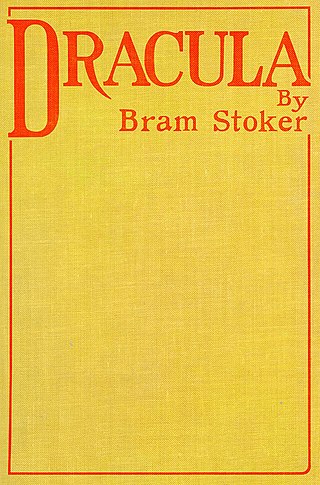
Dracula is a 1897 gothic horror novel by Irish author Bram Stoker. An epistolary novel, the narrative is related through letters, diary entries, and newspaper articles. It has no single protagonist and opens with solicitor Jonathan Harker taking a business trip to stay at the castle of a Transylvanian nobleman, Count Dracula. Harker escapes the castle after discovering that Dracula is a vampire, and the Count moves to England and plagues the seaside town of Whitby. A small group, led by Abraham Van Helsing, investigate, hunt and kill Dracula.

A vampire is a mythical creature that subsists by feeding on the vital essence of the living. In European folklore, vampires are undead humanoid creatures that often visited loved ones and caused mischief or deaths in the neighbourhoods which they inhabited while they were alive. They wore shrouds and were often described as bloated and of ruddy or dark countenance, markedly different from today's gaunt, pale vampire which dates from the early 19th century. Vampiric entities have been recorded in cultures around the world; the term vampire was popularized in Western Europe after reports of an 18th-century mass hysteria of a pre-existing folk belief in Southeastern and Eastern Europe that in some cases resulted in corpses being staked and people being accused of vampirism. Local variants in Southeastern Europe were also known by different names, such as shtriga in Albania, vrykolakas in Greece and strigoi in Romania, cognate to Italian strega, meaning 'witch'.

Nosferatu: A Symphony of Horror is a 1922 silent German Expressionist vampire film directed by F. W. Murnau and starring Max Schreck as Count Orlok, a vampire who preys on the wife of his estate agent and brings the plague to their town.
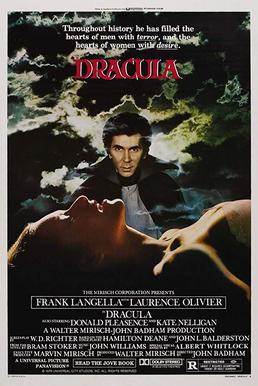
Dracula is a 1979 gothic horror film directed by John Badham. The film starred Frank Langella in the title role as well as Laurence Olivier, Donald Pleasence and Kate Nelligan.

Vampire films have been a staple in world cinema since the era of silent films, so much so that the depiction of vampires in popular culture is strongly based upon their depiction in films throughout the years. The most popular cinematic adaptation of vampire fiction has been from Bram Stoker's 1897 novel Dracula, with over 170 versions to date. Running a distant second are adaptations of the 1872 novel Carmilla by Sheridan Le Fanu. By 2005, the Dracula character had been the subject of more films than any other fictional character except Sherlock Holmes.
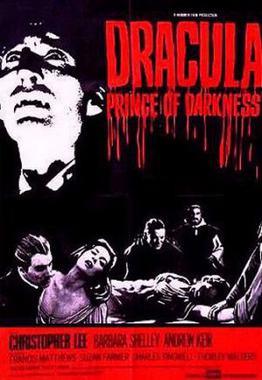
Dracula: Prince of Darkness is a 1966 British gothic supernatural horror film directed by Terence Fisher. The film was produced by Hammer Film Productions, and is the third entry in Hammer's Dracula series, as well as the second to feature Christopher Lee as Count Dracula, the titular vampire. It also stars Andrew Keir, Francis Matthews, and Barbara Shelley.

Nosferatu the Vampyre is a 1979 gothic horror film written and directed by Werner Herzog. It is set primarily in 19th-century Wismar, Germany and Transylvania, and was conceived as a stylistic adaptation of Bram Stoker's 1897 novel Dracula, taking the title, setting and titular character's design from F. W. Murnau's 1922 film Nosferatu: A Symphony of Horror. The picture stars Klaus Kinski as Count Dracula, Isabelle Adjani as Lucy Harker, Bruno Ganz as Jonathan Harker, and French artist-writer Roland Topor as Renfield. There are two different versions of the film, one in which the actors speak English, and one in which they speak German.

The Legend of the 7 Golden Vampires is a 1974 martial arts horror film directed by Roy Ward Baker. The film opens in 1804, when seven vampires clad in gold masks are resurrected by Count Dracula. A century later, Professor Van Helsing, known in the world for his exploits with Dracula, is recruited by a man and his seven siblings after giving a lecture at a Chinese university to take on the vampires. The film is a British-Hong Kong co-production between Hammer Film Productions and Shaw Brothers Studio.

The Satanic Rites of Dracula is a 1973 British horror film directed by Alan Gibson and produced by Hammer Film Productions. It is the eighth film in Hammer's Dracula series, and the seventh and final one to feature Christopher Lee as Dracula. The film was also the third to unite Peter Cushing as Van Helsing with Lee, following Dracula (1958) and Dracula A.D. 1972 (1972).
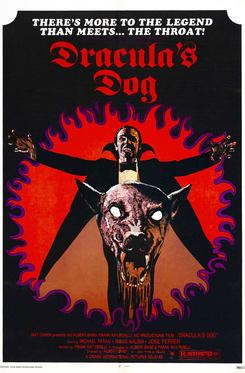
Dracula's Dog, also known as Zoltan... Hound of Dracula, is a 1977 American supernatural horror film directed by Albert Band and starring Michael Pataki and José Ferrer. Its plot revolves around a Doberman Pinscher who is turned into a vampire by a member of the Dracula family, who is also a vampire.

Vampires in Havana is a 1985 Spanish-language adult animated comedy horror film directed by Juan Padrón and features trumpet performances by Arturo Sandoval. It is an international co-production of Cuba, Spain and West Germany.
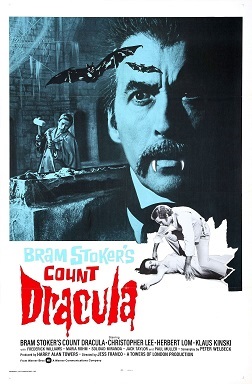
Count Dracula is a 1970 horror film directed and co-written by Jesús Franco, based on the novel Dracula by Bram Stoker. It stars Christopher Lee as Dracula, Herbert Lom as Van Helsing, and Klaus Kinski as Renfield, along with Fred Williams, Maria Rohm, Soledad Miranda, Paul Muller, and Jack Taylor.
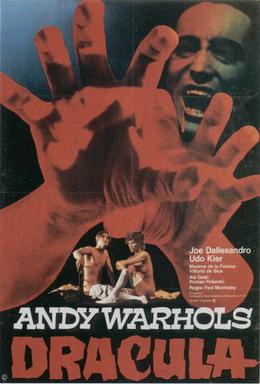
Blood for Dracula is a 1974 horror film written and directed by Paul Morrissey, and starring Udo Kier, Joe Dallesandro, Maxime McKendry, Stefania Casini, Arno Juerging and Vittorio de Sica. Upon its initial 1974 release in West Germany and the United States, Blood for Dracula was released as Andy Warhol's Dracula.

Gianni Garko, often billed as John Garko and occasionally Gary Hudson, is a Dalmatian Italian actor who found fame as a leading man in 1960s Spaghetti Westerns. He is perhaps best known for his lead role as Sartana, starting with the first official film If You Meet Sartana Pray for Your Death and starring in three sequels as this character, the role played by George Hilton in the third film in the series.

Billy the Kid Versus Dracula is a 1966 American horror Western film directed by William Beaudine. The film is about Billy the Kid trying to save his fiancée from Dracula. The film was originally released as part of a double feature along with Jesse James Meets Frankenstein's Daughter in 1966. Both films were shot in eight days at Corriganville Movie Ranch and Paramount Studios in mid-1965; both were the final feature films of director Beaudine. The films were produced by television producer Carroll Case for Joseph E. Levine.

Dracula and Son is a 1976 French comedy horror film directed and written by Édouard Molinaro. The film is about a vampire father and son. Christopher Lee reprises his role as Count Dracula from the Hammer Films Dracula film series.

The character of Count Dracula from the 1897 novel Dracula by Bram Stoker, has remained popular over the years, and many forms of media have adopted the character in various forms. In their book Dracula in Visual Media, authors John Edgar Browning and Caroline Joan S. Picart declared that no other horror character or vampire has been emulated more times than Count Dracula. Most variations of Dracula across film, comics, television and documentaries predominantly explore the character of Dracula as he was first portrayed in film, with only a few adapting Stoker's original narrative more closely. These including borrowing the look of Count Dracula in both the Universal's series of Dracula and Hammer's series of Dracula, including the character's clothing, mannerisms, physical features, hair style and his motivations such as wanting to be in a home away from Europe.

Dracula is a stage play written by the Irish actor and playwright Hamilton Deane in 1924, then revised by the American writer John L. Balderston in 1927. It was the first authorized adaptation of Bram Stoker's 1897 novel Dracula. After touring in England, the original version of the play appeared at London's Little Theatre in July 1927, where it was seen by the American producer Horace Liveright. Liveright asked Balderston to revise the play for a Broadway production that opened at the Fulton Theatre in October 1927. This production starred Bela Lugosi in his first major English-speaking role.
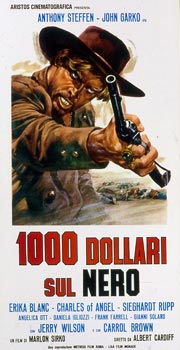
Blood at Sundown is a Spaghetti Western film directed by Alberto Cardone. The film is notable as the primary inspiration for the Sartana film series, starring Gianni Garko as a antiheroic incarnation of the villainous character he previously portrayed in Blood at Sundown.
Dracula is a film series of horror films from Universal Pictures based on the 1897 novel Dracula by Bram Stoker and its 1927 play adaptation. Film historians have had various interpretations over which projects constitute being in the film series; academics and historians finding narrative continuation between Dracula (1931) and Dracula's Daughter (1936), while holding varying opinions on whether Son of Dracula (1943), House of Frankenstein (1944) and House of Dracula (1945) are part of the series. Author and academic Gary Don Rhodes stated the all the mentioned films would require an audience to be familiar with Count Dracula, portrayed by Bela Lugosi, and the various character traits the actor established in the original 1931 film.


















